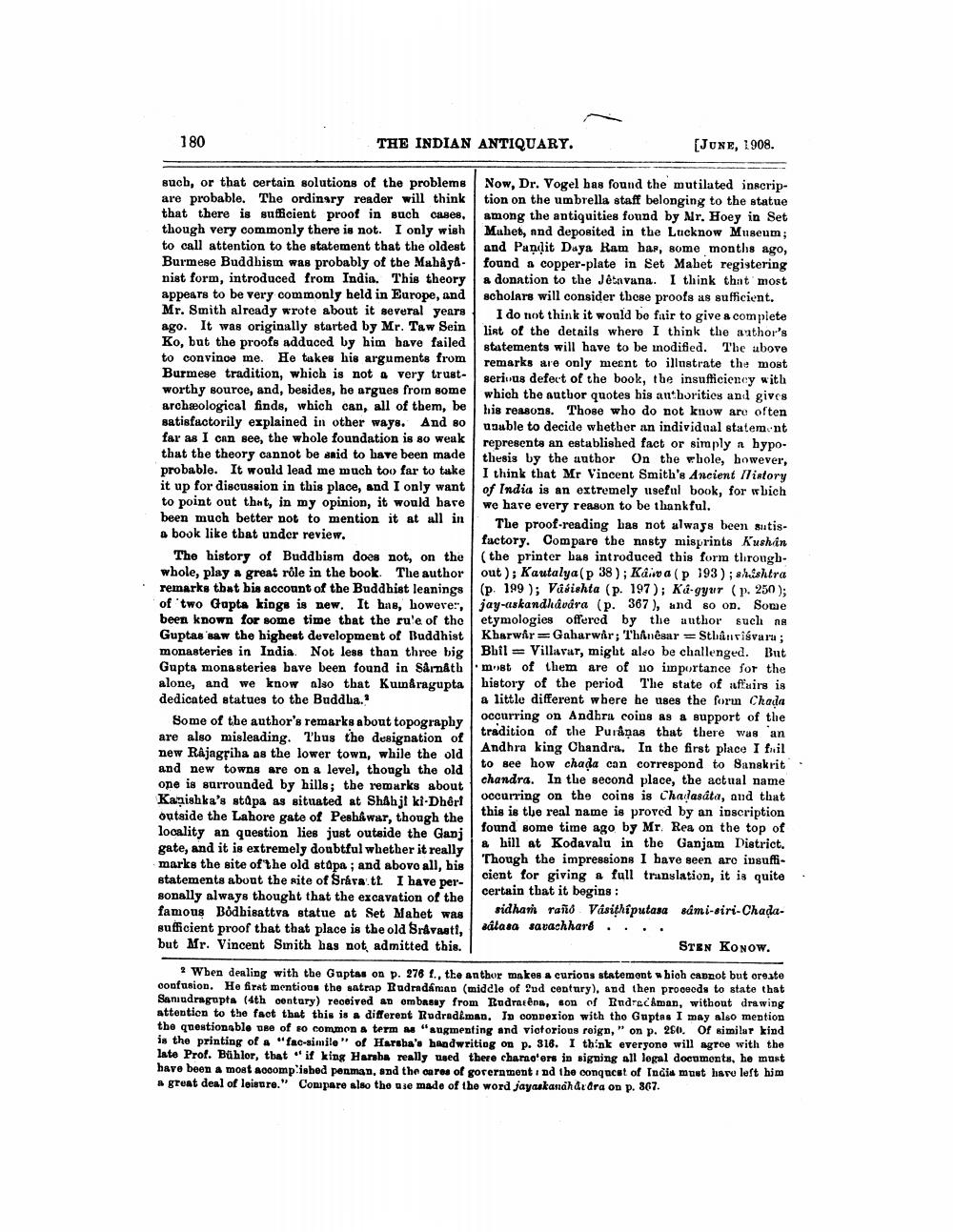________________
180
THE INDIAN ANTIQUARY.
[JUNE, 1908.
such, or that certain solutions of the probleme are probable. The ordinary reader will think that there is sufficient proof in such cases, though very commonly there is not. I only wish to call attention to the statement that the oldest Burmese Buddhism was probably of the Mabaya. nist form, introduced from India. This theory appears to be very commonly held in Europe, and Mr. Smith already wrote about it several years ago. It was originally started by Mr. Taw Sein Ko, but the proofs adduced by him have failed to convince me. He takes his arguments from Burmese tradition, which is not a very trustworthy source, and, besides, he argues from some archæological finds, which can, all of them, be satisfactorily explained in other ways. And so far as I can see, the whole foundation is so weak that the theory cannot be said to have been made probable. It would lead me much too far to take it up for discussion in this place, and I only want to point out that, in my opinion, it would bare been much better not to mention it at all in a book like that under review.
The history of Buddbism does not, on the whole, play a great role in the book. The author remarks that his account of the Buddhist leanings of 'two Gapta kings is new. It has, howere', been known for some time that the rule of the Guptas 'saw the highest development of Buddhist monasteries in India. Not less than three big Gupta monasteries bave been found in Sarnath alone, and we know also that Kumaragupta dedicated statues to the Buddha.
Some of the author's remarks about topography are also misleading. Thus the dusignation of new Rajagriha as the lower town, while the old and new towns are on a level, though the old one is surrounded by hills; the remarks about Kanishka's stūpa as situated at Shahji ki-Dhêri outside the Lahore gate of Peshawar, though the locality an question lies just outside the Ganj gate, and it is extremely doubtful whether it really marks the site of the old stopa ; and above all, bis statements about the site of Sráva.tt. I have personally always thought that the excavation of the famous Bodhisattva statue at Set Mahet was sufficient proof that that place is the old Sravasti, but Mr. Vincent Sunith has not admitted this.
Now, Dr. Vogel has found the mutilated inscription on the umbrella staff belonging to the statue among the antiquities found by Mr. Hoey in Set Muhet, nnd deposited in the Lucknow Museum; and Panļit Daya Ram bar, some months ago, found a copper-plate in Set Mahet registering a donation to the Jêtnvana. I think that most scholars will consider these proofs as sufficient.
I do not think it would be fair to give a complete list of the details where I think the author's statements will have to be nodified. The above remarks are only meant to illustrate the most serivus defect of the book, the insufficiency with which the author quotes his authorities and gives his reasons. Those who do not know are often usuble to decide whether an individual statem-nt represents an established fact or simply a hypothesis by the author on the whole, however, I think that Mr Vincent Smith's Ancient Iistory of India is an extremely useful book, for wbich we have every reason to be thankful.
The proof-reading has not always been sutis. factory. Compare the nasty misprints Kushan (the printer bas introduced this form througbout); Kautalya(p 38); Kaima (p 193 ); sh.shtra (p. 199 ); Vüsishta (P. 197); Ku gyur (P. 250); jay-askandhavara (p. 367), and so on. Some etymologies offered by the author such as Kharwar = Gabarwår; Thânêsar =Stlantiśvara; Bhil= Villavar, might also be challenged. But most of them are of no importance for the history of the period The state of affairs is a little different where he uses the forun Chada occurring on Andhra coins as a support of the tradition of the Puråņas that there was an Andhra king Chandra. In the first place I fuil to see how chada can correspond to Banskrit chandra. In the second place, the actual name occurring on the coins is Chalasata, and that this is the real name is proved by an inscription found some time ago by Mr. Rea on the top of & hill at Kodavalu in the Ganjam District. Though the impressions I have seen aro insufficient for giving a full translation, it is quite certain that it begins :
sidhari raño Vásithíputasa sami-siri-Chadasálasa savachhare ....
STEN KONOW.
? Wben dealing with the Guptas on p. 276 1. the anthor makes a curious statemont which cannot but create confusion. He first mentions the satrap Rudradanan (middle of Pud century), and then proceeds to state that Sansudragupta (4th century) received an ombasay from Rudratons, son of Rudraciman, without drawing attention to the fact that this is a different Rodradi.man. In connexion with tho Guptas I may also mention the questionable use of so common term as "augmenting and viotorious roign," on p. 260. Or similur kind is the printing of a "fac-simile" of Harsha's handwriting on p. 318. I think everyone will agroe with the lato Prof. Bühlor, that if king Haraba really need there characters in signing all legal documents, he must have been a most accomp.isbed penman, and the care of gorernment ind the conquest of India must have left him a great deal of leisure." Compare also the use made of the word jayaskanähdudra on p. 367.




